Vitrectomy is a safer detachment surgery for pseudophakic eyes
A clear view of the ocular fundus allows easy detection of retinal breaks and more precise coagulation.
Click Here to Manage Email Alerts
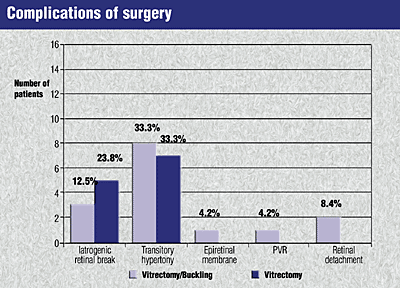 |
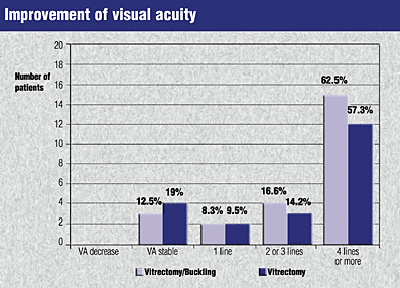 |
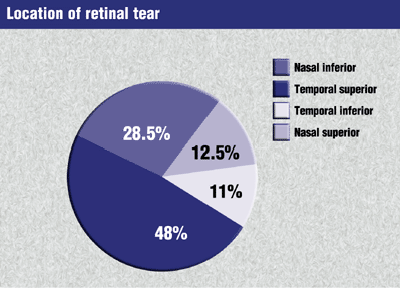 |
GENEVA – Primary vitrectomy, whether or not associated with scleral buckling, is a safe and effective option when treating retinal detachment in pseudophakic eyes, according to a Swiss surgeon.
Constantin J. Pournaras, MD, said “the difficulty of viewing the peripheral retina in pseudophakic eyes accounts for a high number of failures and complications. Vitrectomy offers both the advantages of releasing internal traction and giving a better view of the retina when performing scleral buckling.”
The difficulty of viewing the peripheral retina in pseudophakic eyes is due to the modifications induced by the implantation of an IOL in the anterior segment, such as a smaller pupillary diameter, ir regularity of the pupil edge and the presence of posterior synechiae. Other difficulties may be caused by the presence of cortical remnants, opacification of the posterior or anterior capsule or optical aberrations at the rim of the implant.
“These impediments complicate even further an already unfavorable situation,” Dr. Pournaras explained. “In fact, pseudophakic eyes develop a particular kind of retinal detachment (RD), which is characterized by small retinal breaks, multiple lesions near the ora serrata, the incarceration of the vitreous body into the operative wound leading to tractional detachments, or sometimes by the absence of obvious retinal lesions and the presence of proliferative vitreoretinopathy.”
For all these reasons, he added, the failure rate of conventional buckling surgery is between 10% and 35% in pseudophakic eyes, compared to 9% to 25% of phakic eyes. In addition, postoperative proliferative vitreoretinopathy (PVR) is more frequent in pseudophakic (5% to 20%) than in phakic eyes (5% to 10%).
Prospective study
“In order to ascertain whether primary vitrectomy improves the anatomic and functional outcome of RD surgery in pseudophakic eyes and reduces the rate of re-detachment and proliferative vitreoretinopathy, we carried out a prospective, non-randomized study on 45 patients,” Dr. Pournaras said. “A group of 24 patients were treated by primary vitrectomy and encircling buckling and a second group of 21 by vitrectomy alone. All patients suffered acute retinal detachment following cataract surgery with IOL implantation.”
Preoperative evaluation included measurement of visual acuity, intraocular pressure, anterior and posterior slit-lamp biomicroscopy, indirect and three mirror contact lens biomicroscopy.
“Both groups had similar gender, age, visual acuity (VA), previous cataract surgery technique, anterior segment pathologies and retinal lesion characteristics,” said Dr. Pournaras, of the Genève University Eye Clinic, Switzerland. However, in the vitrectomy group there was a higher number of retinal detachments not involving the macular area. Stage C of PVR was present in only 4 patients of the vitrectomy plus buckling group.
Successful surgery
Surgery was performed under retrobulbar anesthesia. An encircling 2-mm silicone band was placed at the equatorial area, at approximately a 12-mm distance from the limbus, to support the vitreous base. Vitrectomy was performed using a three-port technique under the operating microscope with the use of a wide angle viewing system, the Oculus 130. After removal of the posterior vitreous, perfluoro-n-octane was injected for endodrainage of the subretinal fluid through the retinal holes and to stabilize the central retinal area during examination of the peripheral retina and vitreous base by scleral indentation.
 |
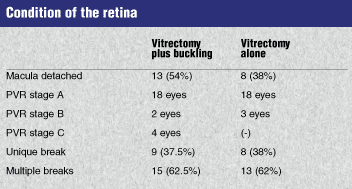 |
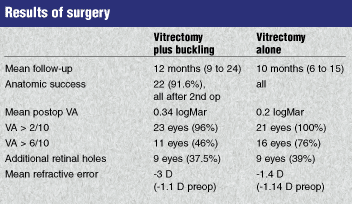 |
Endolaser or cryocoagulation was applied to the retinal breaks, followed by the removal of the perfluoro-n-octane with fluid-air exchange. The operation ended with air-gas exchange (SF6 20% in air). In 9 eyes (37.5%) of the vitrectomy plus buckling group and in 9 eyes (39%) of the vitrectomy group, additional retinal breaks, not seen in the preoperative examination, were detected and treated during vitrectomy.
“All patients were examined daily until they were discharged from hospital,” Dr. Pournaras said. “Thereafter, we saw them at months 1, 2, 3, 6 and subsequently once a year. At the end of follow-up, the retina was reattached in all eyes of both groups. However, in two eyes of the vitrectomy plus buckling group this result was achieved after a second procedure. In one case this was due to an untreated retinal hole, and in the other to the development of stage C PVR.”
The mean visual acuity at the end of the follow up was 0.34 logMar for the vitrectomy plus buckling group and 0.2 logMar for the vitrectomy group. In both groups, almost all eyes achieved visual acuity of 0.2 or better. In the vitrectomy plus buckling group, visual acuity of 0.6 or better was achieved in 11 cases (37.5%), and in the vitrectomy group in 16 cases (76%).
The most common complications of vitrectomy were intraocular hypertension (33% of the eyes in both groups) and iatrogenic retinal breaks. “Intraocular pressure was easily restored to normal values with acetazolamide treatment, and retinal breaks were successfully treated during the course of surgery,” Dr. Pournaras said.
“The anatomic and functional results of our prospective study indicate that pars plana vitrectomy offers a number of advantages in the treatment of the pseudophakic retinal detachment,” he concluded. “The rate of anatomic failure and postoperative PVR is much lower than in extraocular surgery alone. This is mainly due to the clearer view of the ocular fundus that is obtained by the elimination of capsular and vitreous opacities. Retinal breaks are easily detected and a precise cryo or endolaser coagulation can be performed.”
For Your Information:
- Constantin J. Pournaras, MD, can be reached at Hôpitaux Universitaires de Genève, Clinique d’Ophthalmologie, Rue Alcide-Jentzer 22, 1211 Genève 14, Switzerland; +(41) 22-382-83-94; fax: +(41) 22-3828421; e-mail: Constantin.Pournaras@hcuge.ch. Ocular Surgery News could not confirm whether or not Dr. Pournaras has a direct financial interest in any of the products mentioned in this article or if he is a paid consultant for any companies mentioned.
